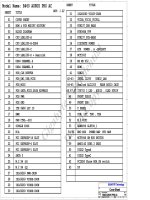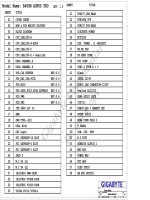a0039 apress pro android apps performance optimization feb 201 morebook vn 0203
Bạn đang xem bản rút gọn của tài liệu. Xem và tải ngay bản đầy đủ của tài liệu tại đây (177.97 KB, 7 trang )
Pro Android Apps
Performance
Optimization
■■■
Hervé Guihot
i
Pro Android Apps Performance Optimization
Copyright © 2012 by Hervé Guihot
All rights reserved. No part of this work may be reproduced or transmitted in any form or by any
means, electronic or mechanical, including photocopying, recording, or by any information
storage or retrieval system, without the prior written permission of the copyright owner and the
publisher.
ISBN-13 (pbk): 978-1-4302-3999-4
ISBN-13 (electronic): 978-1-4302-4000-6
Trademarked names, logos, and images may appear in this book. Rather than use a trademark
symbol with every occurrence of a trademarked name, logo, or image we use the names, logos,
and images only in an editorial fashion and to the benefit of the trademark owner, with no
intention of infringement of the trademark.
The images of the Android Robot (01 / Android Robot) are reproduced from work created and
shared by Google and used according to terms described in the Creative Commons 3.0
Attribution License. Android and all Android and Google-based marks are trademarks or
registered trademarks of Google, Inc., in the U.S. and other countries. Apress Media, L.L.C. is not
affiliated with Google, Inc., and this book was written without endorsement from Google, Inc.
The use in this publication of trade names, trademarks, service marks, and similar terms, even if
they are not identified as such, is not to be taken as an expression of opinion as to whether or not
they are subject to proprietary rights.
President and Publisher: Paul Manning
Lead Editor: James Markham
Technical Reviewer: Charles Cruz, Shane Kirk, Eric Neff
Editorial Board: Steve Anglin, Mark Beckner, Ewan Buckingham, Gary Cornell, Morgan Ertel,
Jonathan Gennick, Jonathan Hassell, Robert Hutchinson, Michelle Lowman,
James Markham, Matthew Moodie, Jeff Olson, Jeffrey Pepper, Douglas Pundick,
Ben Renow-Clarke, Dominic Shakeshaft, Gwenan Spearing, Matt Wade, Tom Welsh
Coordinating Editor: Corbin Collins
Copy Editor: Jill Steinberg
Compositor: MacPS, LLC
Indexer: SPi Global
Artist: SPi Global
Cover Designer: Anna Ishchenko
Distributed to the book trade worldwide by Springer Science+Business Media, LLC., 233 Spring
Street, 6th Floor, New York, NY 10013. Phone 1-800-SPRINGER, fax (201) 348-4505, e-mail
, or visit www.springeronline.com.
For information on translations, please e-mail , or visit www.apress.com.
Apress and friends of ED books may be purchased in bulk for academic, corporate, or
promotional use. eBook versions and licenses are also available for most titles. For more
information, reference our Special Bulk Sales–eBook Licensing web page at
www.apress.com/bulk-sales.
The information in this book is distributed on an “as is” basis, without warranty. Although every
precaution has been taken in the preparation of this work, neither the author(s) nor Apress shall
have any liability to any person or entity with respect to any loss or damage caused or alleged to
be caused directly or indirectly by the information contained in this work.
Any source code or other supplementary materials referenced by the author in this text is
available to readers at www.apress.com. For detailed information about how to locate your book’s
source code, go to />
Contents at a Glance
Contents ............................................................................................................. iv
About the Author.............................................................................................. viii
About the Technical Reviewers ......................................................................... ix
Acknowledgments .............................................................................................. x
Introduction ....................................................................................................... xi
■Chapter 1: Optimizing Java Code .................................................................... 1
■Chapter 2: Getting Started With the NDK ....................................................... 33
■Chapter 3: Advanced NDK.............................................................................. 73
■Chapter 4: Using Memory Efficiently ........................................................... 109
■Chapter 5: Multithreading and Synchronization ......................................... 133
■Chapter 6: Benchmarking And Profiling ...................................................... 163
■Chapter 7: Maximizing Battery Life ............................................................. 177
■Chapter 8: Graphics ..................................................................................... 207
■Chapter 9: RenderScript .............................................................................. 231
Index ............................................................................................................... 265
iii
Contents
Contents at a Glance .......................................................................................... iii
About the Author.............................................................................................. viii
About the Technical Reviewers ......................................................................... ix
Acknowledgments .............................................................................................. x
Introduction ....................................................................................................... xi
■Chapter 1: Optimizing Java Code .................................................................... 1
How Android Executes Your Code ...........................................................................................................................2
Optimizing Fibonacci ..............................................................................................................................................4
From Recursive To Iterative ...............................................................................................................................5
BigInteger ..........................................................................................................................................................6
Caching Results ....................................................................................................................................................11
android.util.LruCache<K, V>............................................................................................................................12
API Levels .............................................................................................................................................................13
Fragmentation..................................................................................................................................................16
Data Structures .....................................................................................................................................................17
Responsiveness ....................................................................................................................................................20
Lazy initializations ...........................................................................................................................................22
StrictMode .......................................................................................................................................................23
SQLite ...................................................................................................................................................................25
SQLite Statements ...........................................................................................................................................25
Transactions ....................................................................................................................................................28
Queries .............................................................................................................................................................30
Summary ..............................................................................................................................................................31
■Chapter 2: Getting Started With the NDK ....................................................... 33
What Is In the NDK? ..............................................................................................................................................34
Mixing Java and C/C++ Code ...............................................................................................................................37
Declaring the Native Method ...........................................................................................................................37
Implementing the JNI Glue Layer .....................................................................................................................38
Creating the Makefiles .....................................................................................................................................40
Implementing the Native Function ...................................................................................................................41
Compiling the Native Library............................................................................................................................43
Loading the Native Library ...............................................................................................................................43
iv
Index
cache line size, 119–120
cache miss, 119
comparing two values, 113–115
Level 1 and 2 cache, 119
sorting arrays, 116–117
sorting, finding and summing,
115–116
sum of two 32-bit values, 111
garbage collection, 125
GC_CONCURRENT, 130
GC_EXPLICIT, 130
GC_EXTERNAL_ALLOC, 130
GC_FOR_MALLOC, 130
GC_HPROF_DUMP_HEAP, 130
log messages, 130
memory leaks, 125–127
references, 127–130
getMemoryInfo() methods, 131
Java primitive types, 110
modified MyRecords class
using short array, 123
using two array, 124–125
modified sum values(), 122
onLowMemory(), 131
performance, 110
physical memory, 109
Record class, 121
saving records, 121–122
virtual memory swapping, 109
Mipmaps, 226–227
Multithreading and synchronization, 133
activity’s lifecycle
computation, progression,
158–161
Fibonacci Number computation,
154, 155
passing information, 156–158
AsyncTask, 137
multiple file downloading, 138
protected methods, 138
sequence implementation, 137,
138
UI thread and execution, 139
concurrency, 147
data types
Java language, 143, 144
synchronized keywords, 143, 144
Synchronized Statements, 146
volatile keyword addition, 145
handlers, 140–142
loopers, 142
multicore
algorithm modification, 149–152
concurrent cache, 152–154
dual core CPUs, 148, 149
threads
code execution, 134
creation, 134
Fibonacci number computation,
135
non-UI thread, 135
priority, 136–137
■ N, O
Native code, 35
NEON registers, 96
Network location provider, 194
■ P, Q
Passive location provider, 195
■R
RenderScript, 231
Balls sample application, 231
Hello rendering, 236
Content View setting, 239, 240
RenderScriptGL context creation,
238
RSSurfaceView, 239
script creation, 237
Hello, World script, 233
auto-generated file, 234, 235
calling function, 235
LLVM Assembly Language, 236
HelloCompute
allocations, 244, 245
performance, 248, 249
RenderScript mono.rs, 243
root() function, 244
269
270
Index
rsForEach function, 245–248
LLVM bitcode, 233
native code, 233
native RenderScript APIs
definition, 249, 250
rs_atomic.rsh, 262
rs_cl.rsh, 255–258
rs_core.rsh, 253–255
rs_graphics.rsh, 260–261
rs_math.rsh, 259–260
rs_time.rsh, 261, 262
rs_types.rsh, 250–253
vs. NDK, 263
variable addition
alpha component, 242
background Color, 240
blue variable, 242
get() method, 243
global red and green variable,
242
ScriptC_hellorendering2.java,
241, 242
YouTube Carousel view, 231
■S
SQLite
queries, 30–31
SQLite statements
cheese database, 26
compilation, 27
execution, 25
populateWithCompileStatement,
28
StringBuilder/String format
version, 26
transactions, 28
Atomic commit, 28
performance, 29
System.nanoTime(), 164, 165
■ T, U
Textures, OpenGL ES, 221
ARM Mali GPU Compression tool,
223, 224
compression formats, 221
ETC1 compression format, 222
ETC1 compression vs. original
image, 222
etcpack tool, 222
Imagination Technologies, 224
manifest, 225, 226
PowerVR, 225
uncompressed textures, 221
■ V, W, X, Y, Z
Virtual register, 3









